Benefits
Earth-based radar observations provide an extremely powerful tool to characterize the physical properties and dynamics of near-Earth asteroids (click here for examples). This characterization is essential in four contexts:
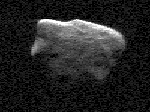
scientific understanding |
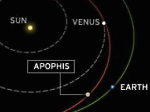
impact hazard mitigation |
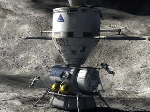
human exploration |
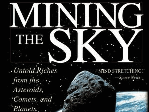
resource utilization |
A well-conceived spacecraft mission to asteroids will certainly be preceded by ground-based radar reconnaissance of the target body, which often produces a series of radar images at ~10 m resolution. With a sequence of such images, three-dimensional shape models can be produced. The radar data provide precise estimates of the size, spin, shape, reflectivity, and wavelength-scale roughness of the asteroid. For binary systems, which are common in the near-Earth population, knowledge of the asteroid mass and density is also accessible.
History
The field of Asteroid Radar Astronomy started with the detection of near-Earth asteroid (1566) Icarus on June 13-15, 1968 at Haystack (Pettengill et al 1969) and June 14-16 at Goldstone (Goldstein 1968). The first asteroid detection at Arecibo was of (433) Eros in 1975 (Campbell, Pettengill, Shapiro 1976), which was also detected at Goldstone (Jurgens and Goldstein 1976). The first detection of a main belt asteroid, (1) Ceres, took place at Arecibo in 1977 (Ostro et al 1979). The detection rate of asteroids remained modest (<10/year) until the upgrade of the Arecibo radar in the late 1990s. Since then, dozens of asteroids have been detected each year. Steven J. Ostro (1946-2008) devoted most of his career to asteroid radar astronomy.
Sensitivity
The Arecibo radar can detect a substantial fraction of the near-Earth asteroid population. The figure below shows the expected performance at a declination of 18 degrees, which maximizes track duration. Numbers will be slightly lower at other declinations due to shorter track times and gain reduction. For Goldstone, divide the numbers by 20.
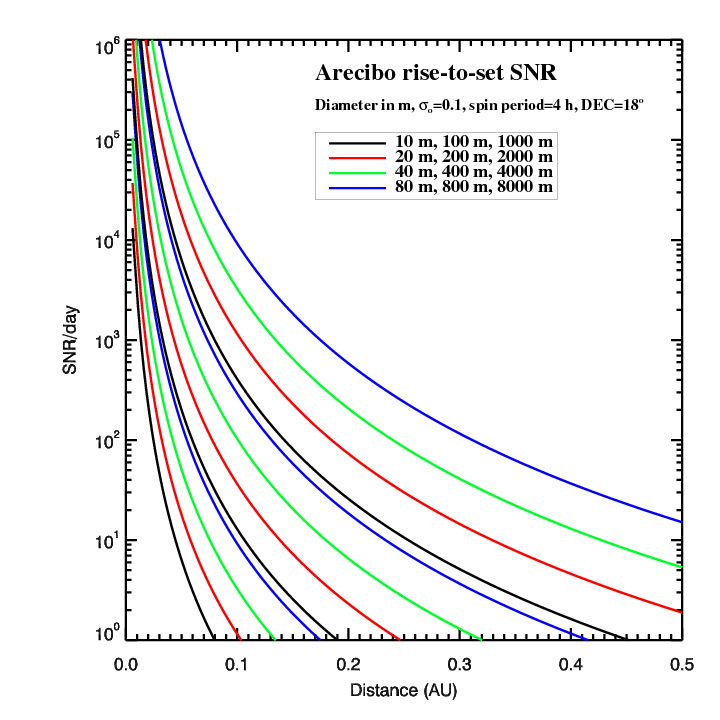
Further reading
If you are interested in learning more about the impact of asteroid radar astronomy, here is a Top 10 list of Near-Earth Asteroid Radar publications, by citations (Citation count is from Thomson Reuters Web of Science, May 29, 2013).
| Authors | Title or abbreviated title | Citations |
| Margot, Nolan, et al. (2002) | Binary Asteroids in the Near-Earth Object Population | 101 |
| Hudson and Ostro (1994) | Shape of Asteroid Castalia from Inversion of Radar Images | 94 |
| Hudson and Ostro (1995) | Shape and Non-Principal Axis Spin State of 4179 Toutatis | 88 |
| Ostro, Hudson et al. (2000) | Radar Observations of Asteroid 216 Kleopatra | 80 |
| Ostro, Margot, et al. (2006) | Radar Imaging of Binary Near-Earth Asteroid 1999 KW4 | 74 |
| Ostro, Chandler, et al. (1990) | Radar images of asteroid 1989 PB | 62 |
| Ostro, Rosema, et al. (1991) | Asteroid 1986 DA - evidence for a metallic composition | 61 |
| Taylor, Margot, et al. (2007) | Spin Rate of Asteroid 54509 Increasing Due to YORP | 53 |
| Ostro, Hudson, et al. (1995) | Radar Images of Asteroid 4179 Toutatis | 47 |
| Ostro, Campbell, et al. (1991) | Asteroid radar astrometry | 45 |